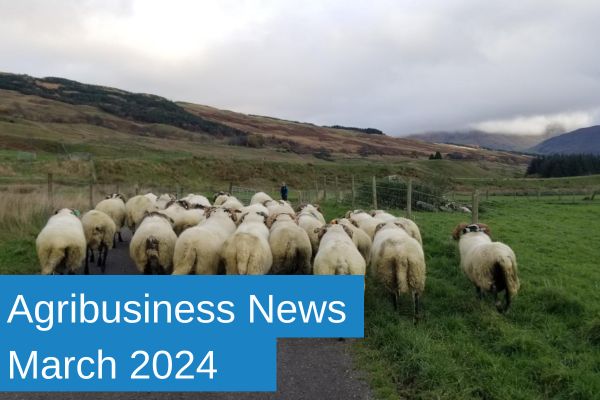Agribusiness News March 2024 – Sheep
1 March 2024Recent figures from HMRC have shown that in 2023 red meat exports to the European Union were comparable in value compared to 2022 (an increase of 2%), although the volume was 12% lower than the previous year. The red meat which aided this value was sheep meat, where an increase of 23% of value and volume was exported to the high value market in France. Exports to Germany also showed increases in value and volume of 15% and 12% respectively. Non-EU markets showed an increase of volume by 10%, however the value decreased by 15%. In contrast to the sheep meat, beef exports dropped by 15% in volume and 9% in value, largely due to the strong domestic demand in the UK.
Unbelievable Prices
The hogg trade is currently flying with prices rocketing due to an estimated 430,000 fewer lambs (or 10%) being carried over from the 2023 crop, compared to the previous year. Combined with the timing of both Ramadan and Easter in March, and the extra demand this brings.

The timing of the religious festivals is set for us to see record prices for sheep meat into March and will enable the hogg trade to finish on a high.
As new season lamb comes forward, this may change, with a predicted high lamb crop of 16.4 million head (2% up on the year). However, many early lamb producers in the south have been hit with midge related health problems – Schmallenberg and Blue Tongue which has led to high losses of lambs due to high barren rates, abortions, low milk yields and deformities. This will affect this predicted lamb numbers and the speed that lambs come to the market, resulting in a slow start for the new season lamb in terms of volume.
Marketing New Season Crop to Europe
Europe is set to remain our largest exporter. Their national flock is decreasing, and the effects of midge related health issues (Schmallenberg and Blue Tongue) could have a large impact on the productivity of our national flock. While consumption of lamb remains stable, there is an opportunity for the UK product to grow in this market.
We will have competition with cheaper global products such as Australian and New Zealand lamb. However, we have seen how recent conflict in the Middle East (Israel and Gaza conflict) can increase shipping costs and add ~10 days on for rerouting which disrupts trade, making the cheaper product less attractive.

Australia’s final 2023 slaughter statistics are in where the record quantity has been recorded, at 24,909,600 head, a staggering rise of 16.38% on the year. This is increased production is definitely a huge risk as we go into Ramadan, Easter and the next crop of lambs, as their free trade quota has grown to the UK. At the same time, our consumption of lamb is decreasing.
The economic outlook for 2024 looks more positive with inflation set to decrease. However, the need for quick, easy and cheap family meals is set to grow, which will no doubt, drive the retailer to the cheaper foreign product rather than our home grown, natural, low carbon, high welfare, sustainable lamb! This makes it more important than ever to shout about the credentials of choosing and eating homegrown protein sources!
Kirsten Williams; 07798617293

Sign up to the FAS newsletter
Receive updates on news, events and publications from Scotland’s Farm Advisory Service

